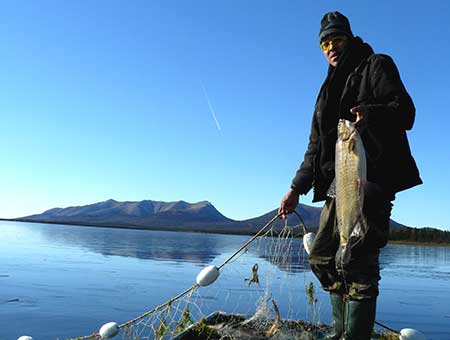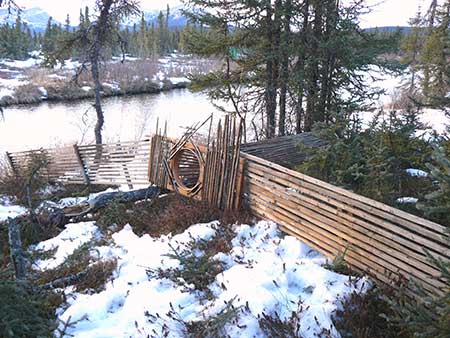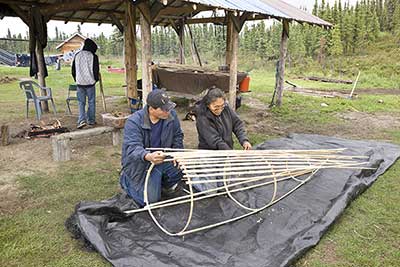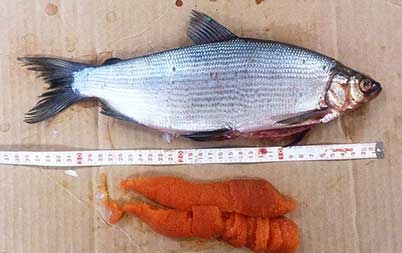Alaska Fish & Wildlife News
July 2015
Subsistence on the Kuskokwim
Whitefish, Fishtraps, and the Stony River Dena’ina

After slowly making a tight turn around a bend in the creek, Fred guns the throttle on the motor powering his 15-foot handmade wooden skiff. “Beaver dam, hang on,” he yells back to me. To continue further upstream there is no route other than straight over the beaver’s intricate assemblage of sticks and logs, which block all open water flowing down “Abundance Stream,” or Hek’dichen in the Stony River dialect of the Dena’ina Athabascan language. We blast over the dam and for a split second seem to launch into the air. “Woohoo!” This is my kind of boat ride. Jumping beaver dams in a wooden skiff on a creek deep in the Alaska Interior makes for excitement. For Fred Bobby, a 48-year-old lifelong Lime Village resident, beaver dams are a hindrance more than anything else. “You can break the beaver dams and then you wake up the next morning and they [beavers] already got it fixed,” he explains.
Lime Village and Hungry Creek
Labeled Hungry Creek on USGS maps, Hek’dichen is a tributary of the Stony River which drains a series of lakes in the lowlands of the upper Kuskokwim River valley. These lakes and Hungry Creek are of great historical and contemporary importance to the Stony River band of Dena’ina as traditional hunting, fishing, and gathering areas. The official Hungry Creek label is misnomer which implies a scarcity of food. The original Dena’ina designation as “Abundance Stream” reflects its actual history as a watershed where the Stony River people could always go to find food when in need. The contemporary community of Lime Village, Hek’dichen Hdakaq’, or “Abundance Village” was established at the ancient inhabitation site where Hungry Creek drains into the Stony River proper.
The Kuskokwim River flows approximately 803 river miles from the headwaters of the South Fork Kuskokwim River in the Alaska Range, and 962 river miles from the headwaters of the North Fork Kuskokwim River near Lake Minchumina, to its mouth at Kuskokwim Bay, in the Bering Sea, on the state’s southwestern coast. The entire Kuskokwim River drainage covers approximately 50,200 mi², transitioning from glacial alpine and boreal forest headwater areas in the Interior, to subarctic tundra of the Yukon-Kuskokwim Delta in western Alaska. Major tributaries of the upper Kuskokwim River include the Stony, Swift, Selatna, Takotna, Big, South Fork Kuskokwim, and North Fork Kuskokwim river drainages. Permanent upper Kuskokwim River region communities include Nikolai, Telida, Takotna, McGrath, and Lime Village, which is the only permanent community within the Stony River drainage.
With a current population of 34 persons, mostly Dena’ina, residing in 14 households, Lime Village is located in the western foothills of the Alaska Range on the southwest bank of the Stony River, approximately 60 miles upriver from its confluence with the Kuskokwim River. The Kuskokwim’s confluence with the Stony River sits at approximately river mile 333.
Lime Village is only accessible by small boat or by chartered air service and is considered to be the most remote Dena’ina Athabascan community. Lime Village has strong kinship and cultural ties to Nondalton, another Dena’ina community located 98 miles to the south. Although this portion of Dena’ina Athabascan territory is sparsely populated, it is on the Stony River near the present day Lime Village that the Dena’ina as a whole are thought to have originated. Indeed, in Dena’ina, the Stony River-Telaquana Lake people are referred to as Htsaht’ana—“the first people.”
Wildlife and Fish
Traditionally moose, caribou, and black bear are known to be abundant in the Hek’Dichen watershed, as are waterfowl. During our travels in the area, a handful of mallards are harvested and brought back to the village. This is also good spruce grouse country. In the mornings I follow young Dena’ina hunter Tristan Stickman on his walks in search of grouse. At 9 years old he is becoming a crack shot with a .22, and we both enjoy the praise from the elders when we return with a few birds. Butch Hobson, a Dena’ina elder visiting from neighboring Nondalton, instructs the two of us in the Denai’na way of preparing birds by plucking the feathers, singing what is not easily plucked over a fire, removing the heads, feet, wings, and guts, but retaining the livers, hearts, and gizzard, which are cleaned and stuffed back in the birds for cooking.

The Hungry Creek watershed is also precious to the Stony River people for its fish, not for salmon, but grayling, pike, and at least three species of whitefish. It is the whitefish in particular that brought me to visit Lime Village multiple times during 2013 and 2014, as a researcher for a nonsalmon fish study being conducted by ADFG Division of Subsistence, and funded by the federal Office of Subsistence Management Fisheries Resource Monitoring Program. The purpose of our project was to update subsistence whitefish harvest and use information, and to document trends in the subsistence harvest of whitefish in the upper Kuskokwim River area.
Other than a recent USFWS fisheries inventory and two past Division of Subsistence studies, little is known about whitefish abundance, behavior, and distribution in the Stony River watershed. Yet, the Stony River people’s and the Lime Village community’s long-term reliance on whitefish as subsistence resource have been thoroughly documented. Ever since the Dena’ina have inhabited the region, their spring and fall occupation sites have centered around having access to whitefish. In fact, whitefish were viewed by the Stony River people as being just as valuable, if not more valuable, than the abundant salmon that could be harvested from the main stem of the Stony River during the summer months.
During times in the past when residents relied primarily on dog teams for transportation, nonsalmon fish, including whitefish, were likely just as important for dog food as they were as a source of food for people. However, the adoption of motorized transportation during the late 1960s initiated a decline in Lime Village’s use of dog teams and thus a concomitant decline in the community’s need to harvest large quantities of nonsalmon fish. Nonetheless, today, Lime Village residents continue to harvest whitefish every year, though not as intensively as in the past.
Lime Village residents cited five main reasons for the community’s decline in whitefish fishing effort: availability of store-bought food; employment that provides income to purchase store-bought food; the availability of motorized transport such as snowmachines, ATVs, and motorboats and a resulting end of the community’s use of dog teams for transportation; increasing levels of beaver dams, which respondents suggest have blocked whitefishes’ migration in the creeks where they are normally found; and younger generations not learning and practicing the traditional activities of the community.
During our study, Lime Village residents harvested and used broad whitefish, humpback whitefish, least cisco, and, to a limited extent, sheefish. Residents often referred to the various whitefish species in their Dena’ina names, especially telay—broad whitefish. Dena’ina names for the other whitefish species are humpback whitefish—hulehga, least cisco—ghelghuli, which Lime Village residents often call “herring,” sheefish—shish, and round whitefish—hasten. The Dena’ina name for northern pike is ghelguts’i. Longnose suckers are called duch’ehdi.

Fall is the primary time that Lime Village residents pursue whitefish. As whitefish begin to migrate out of lakes and into the creeks for their winter migration downriver, residents target them at traditional fall whitefish camp locations. It was traditional for the Stony River Dena’ina to relocate to whitefish camps around mid-August. This gave them time to prepare the camps and fishing gear prior to the time the whitefish began running in late August. By mid-September whitefishes, especially broad whitefish, become abundant. Lime Village elder Phil Graham explained that the amount of whitefish in the creeks increases as temperatures drop, because as the weather becomes colder, more whitefish travel downstream. “When it started to get cold then the whitefish would come down,” said Graham. 70 year old elder Helen Dick explained that mostly broad whitefish are caught up until early October, “And then later [as it gets colder] the little ones come, ghelghuli [least cisco]. Regarding the best season to target least cisco, Fred Bobby said, “It varies. You have to catch them [least cisco] at the right time. Like right before the lake freezes they hit.” Freeze-up usually occurs between mid-October and early November in the Lime Village area.
Trapping Whitefish
Wooden fish traps are an important traditional method used by the Upper Stony River Dena’ina to capture whitefish. Lime Village residents explained that fish traps are designed to capture whitefish when they leave lakes and travel down narrow, shallow creeks in the fall or when they travel up these creeks to return to lakes in the spring. Fish traps were most often placed at the outlets of a lake or the mouths of creeks. Lime Village elders explained traditional fish traps are the superior method for catching large numbers of whitefish but that the method had largely fallen out of use by the community during the end of the 20th century.
There are two basic styles of fish traps used traditionally by the Upper Stony River Dena’ina. The first is a basket style trap, called taz’in, and the second is an open style trap called hchil[i]. Both of these traps employ the use of split spruce fencing that leads fish into an enclosure. The basket style trap, or taz’in, consists of a fence, which simultaneously leads the fish and blocks the creek, and a long and straight cylindrical basket, which the fish enter through the wide end of a separate cone shaped basket.
The tail of the main basket can be configured in two different ways. The traditional design finished the cylindrical tube with the slats tapered into a cone, which needed to be lashed tightly so the fish could not escape. The second method consists of a removable door on the far end of a cylinder, which is opened when the basket becomes full of fish. When the door is opened, a person stands guard with a dipnet and captures the fish in the net as they try to escape. A second person operates the door, closing it after each dip in order to ensure that the fish do not escape. Respondents explained that this type of trap was normally built to harvest smaller fish, such as least cisco and Arctic grayling.
The open style trap, or hchil, does not employ a basket and instead consists entirely of fencing. In this configuration, sections of fence are placed in the stream to guide fish through the door of an open enclosure that is made of more sections of fence. Once enough fish have entered the enclosure, the door entrance is closed, trapping the fish. The fish are then brought to land with a dipnet. “They would use piles of rocks to hold the door closed while they were dipping,” explained 92-year-old Lime Village elder Nick Alexie. Hchil’s were normally built to harvest larger fish such as broad whitefish.

Each of the traps described above were traditionally made of split spruce lashed with root, although as one respondent explained, in modern times, fences, baskets, and entrance funnels were also sometimes wrapped with chicken wire rather than with spruce slats. Dipnets were made with a spruce pole for a handle, a spruce sapling for the hoop, and spruce root, sinew, or willow bark for the mesh. In later years Lime Village residents attached modern nylon fish netting to their spruce framed dipnets.
Construction of the traditional Upper Stony River Dena’ina basket style whitefish trap (taz’in) is a detailed process, normally requiring that a family spend multiple days working together to complete the trap. Because of its strength, spruce is the primary material required for construction of the trap. Other woods will not work because they break easily and will rot in the water. An intimate knowledge of spruce wood is necessary for selection of proper spruce trees in the field. Spruce used to make the trap must be green and thus come from a live tree. Helen Dick said that the best time to harvest spruce for the trap is during spring “when the snow began melting.” Trap makers select only straight grained spruce trees with very few knots, because this is the strongest and most flexible wood.
Once the trees are selected, they are then split into the multiple slats that will make up the basket portion of the trap and the fence portion. The wood is split by driving an axe and handmade spruce wood wedges with a wooden mallet, also made from spruce. Even when available, Lime Village people do not use modern table saws or metal wedges and instead use only an axe and spruce wedges to split the wood, because table saws easily cut across the grain, and slats that are cut across the grain will break.
The first goal is to split the tree in half in as straight a line as possible. The split is begun with an axe right on one of the annular rings in the middle of the mass of the wood. After the cut end of the log splits, the long side will start splitting and more wedges are placed in this crack. The formula is to always start the split with the axe and follow the widening split along the log with the wedges, putting in more wedges until the end of the log is reached. The wedges are then pounded deeper until the log splits. The trap maker must monitor the progress of the split to make sure it does not go crooked. If the split starts going crooked, the trap maker leaves a wedge in the original split and begins a new split ahead of it with the axe, working back towards the wedge. This normally corrects the crooked split. Using the same process as described above, the halves of the log are split into quarters, and then eighths, then sixteenths, and so on, until the trap maker has produced a bundle of raw slats. Approximately 100 1" wide by ½"–¼ " tall slats are needed to make the fence and trap.
The slats used for the hoops are worked into shape and bent into hoops without breaking or splintering. To do this, the trap maker patiently bends the hoop slats around a tree-sized pole in order to flex the grain. Once the bend is established, the slats are bent into hoops and tied in place with spruce roots to hold their shape while they dry. Spruce roots are carefully selected from a long slender tree with tough branches (and also tested by bending); these trees produce long, slender, strong roots. A series of straight slats are lashed with spruce roots onto these hoops. The funnel component of the trap leads the fish into the trap and needs to fit flush into the basket of the trap. The hoops for the funnel component are made in decreasing diameters as they move toward the rear of the cone.

As evident from the discussion above, construction and use of the traditional Upper Stony River Dena’ina whitefish trap requires large amounts of time, labor, and effort. During our study some elders complained that most of the younger generation had not learned the skill of constructing traditional Upper Stony River Dena’ina whitefish traps. While Lime Village residents use set gillnets to take all of their broad whitefish and humpback whitefish harvests, in 2013 the Bobby family, with Fred in the lead, constructed a wooden fish trap and used it to take all of the community’s least cisco harvest at Shagelagh, a historically important seasonal fish camp on the isthmus between Kutokbuna Lake and Trout Lake.
This camp is adjacent to Niltudeqnilen “currents join” creek, which drains from Kutokbuna Lake, Shagela Vena, northward into Trout Lake. Shagelagh is a traditional and primary least cisco harvest location for Lime Village residents. Helen Dick was born at Shagelagh in May 1945 during her family’s spring fishing activities. Her father Pete Bobby was also born at Shagelagh, and it was at this location that generations of the Bobby family have learned to fish for whitefish.
Fred was inspired in the construction and use of traditional Upper Stony River Dena’ina taz’in by the discovery of a large bundle of old spruce slats his late grandfather Vonga Bobby had left in an old storage shed. Fred reassembled the old slats into a fence and a basket and, alongside other family members of the younger generations, successfully harvested hundreds of least cisco at Shagelagh.
As local partners in this Fisheries Research Monitoring project, Lime Village residents provided extremely valuable local traditional knowledge of the Upper Kuskokwim River whitefish fishery and displayed their continuing reliance on whitefish as a subsistence resource. Moreover, the prehistoric Dena’ina fish trap construction knowledge was revived and is now being passed on and utilized by younger generations of Stony River Dena’ina. It was a privilege to be an ADF&G researcher for this project[i].
James Van Lanen is a Subsistence Resource Specialist for ADF&G Division of Subsistence, currently based in Anchorage.
[i] The comprehensive results of the research described here, as well as results from research conducted in the community of Nikolai can be found in Van Lanen, J. M., D. Runfola, and D. Koster. 2015. Whitefish Trends on the Upper Kuskokwim River: Ethnographic Overview and 2012–2013 Nonsalmon Fish Harvests, Nikolai and Lime Village, Alaska. Alaska Department of Fish and Game Division of Subsistence, Technical Paper No. 407, Anchorage. http://www.subsistence.adfg.state.ak.us/TechPap/TP407.pdf
[i] Under State regulation both the open style hchil and basket style taz’in fish traps are described as fyke nets and are a legal method for the harvest of nonsalmon fish in the Kuskokwim River basin.
Subscribe to be notified about new issues
Receive a monthly notice about new issues and articles.
